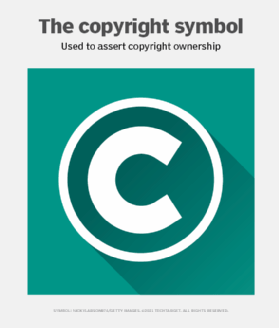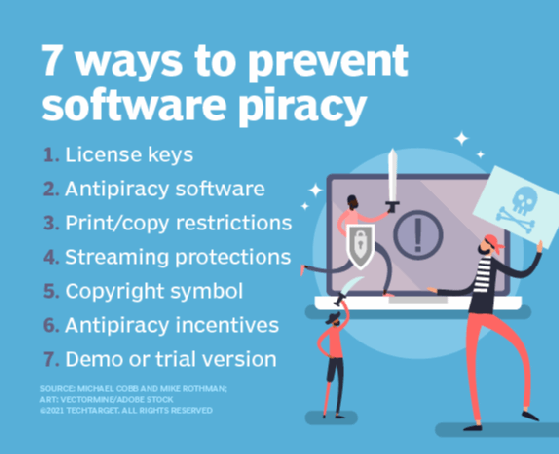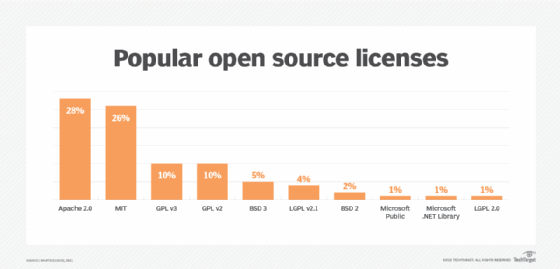copyright
What is copyright?
Copyright is a legal term describing ownership of control of the rights to the use and distribution of certain works of creative expression, including books, video, motion pictures, musical compositions and computer programs. Historically, copyright law has been enacted to balance the desire of cultures to use and reuse creative works -- thus creating "derivative work" -- against the rights of authors of art, literature, music and the like to monetize their work by controlling who can make and sell copies of the work.
To strike this balance, the exclusivity of control is almost always restricted to a set period of years, after which a copyright-protected work reverts to the public domain and may be freely used.
Who is a copyright owner?
The copyright holder is often a company or corporation. If a work is created as a component of employment -- work for hire -- then the copyright for the work defaults to the employer.
Copyright ownership is bounded by the territory of the jurisdiction in which it has been granted -- a copyright granted by the United States is valid only within that country, for example -- as well by certain specific exceptions. Much of international copyright law was brought into relative conformity with the Berne Convention for the Protection of Literary and Artistic Works -- usually referred to as the Berne Convention -- in 1886, with numerous subsequent revisions over the decades. The World Intellectual Property Organization Copyright Treaty -- also known as the WIPO Copyright Treaty or WCT -- was adopted in 1996 to cover information technology and the internet, elements not directly addressed in the Berne Convention.

An important shift in copyright legislation that appeared in the Berne Convention was the move to make copyright protection automatic. In most countries today, creators do not need to register or apply for copyright protection of a work. Rather, the author of a work is immediately entitled to all copyrights of the work until those rights are explicitly disclaimed or the copyright expires.
Before 1989, United States law required the use of a copyright notice to assert that copyright was being claimed. The copyright symbol or the word copyright had to be placed somewhere within the protected work, along with the year the work was created or published.
What is the duration of copyright protection?
After a work's copyright expires, the work falls into the public domain and can be used at no cost and without restriction. The original copyright term was set at 14 years, with the option to renew for another 14 years. That term was doubled in 1831 to 28 years plus one 28-year renewal.
Disney Corp. is the best known of a group of powerful copyright holders that benefit from longer copyright protection terms. Disney has been a driving force to extend U.S. copyright protection for its iconic mouse and supported changes to copyright terms in the U.S., including the following:
- Copyright Act of 1976, which extended copyright protection to 75 years or the life of the author plus 50 years; and
- Copyright Term Extension Act of 1998, also called the Mickey Mouse Protection Act, which extended the term to 120 years or the life of the author plus 70 years.
Under current copyright law, Disney's copyright on the original version of Mickey Mouse portrayed in Steamboat Willie in 1928 is set to expire in 2024. However, subsequent versions of the Disney mascot, as well as most of Disney's other characters, will still be protected.
What is the duration of copyright protection under current law?
Under current law in the U.S., works created after Jan. 1, 1978, are afforded copyright protection for the life of the author plus an additional 70 years. For anonymous, pseudonymous and corporate-owned works, a copyright lasts 95 years from the year of its first publication or a term of 120 years from the year of its creation, whichever expires first.
Copyright duration and public domain
The notion of protecting publishers from unauthorized third-party sales of copies of their books dates back to the 1709 Statute of Anne in Britain, a law that gave publishers exclusive publishing rights for a fixed period, after which their work could be produced and sold by others. In the United States, the first legislation along these lines appears in the U.S. Constitution, in Article I, Section 8, Clause 8, where the so-called Copyright Clause gives Congress the authority to enact laws "securing for limited Times to Authors and Inventors the exclusive Right to their respective Writings and Discoveries."
Both these laws, along with current copyright legislation worldwide, call for protected works to enter the public domain after the copyright law's stipulated term has passed. Works in the public domain may be used, copied and distributed with no restrictions under copyright law.

What are the exceptions to copyright?
Not every expression of an idea may be copyright-protected. Copyright doesn't protect the following:
- product names;
- titles of works, such as book titles;
- names of businesses and organizations;
- pseudonyms, including computer hacker nyms;
- slogans, catchphrases, mottos and short advertising phrases; and
- lists of ingredients, such as on product labels or as used in recipes.
Some things on this list, such as product names, may be afforded protection under trademark law.
Fair use
Even when a work is protected under copyright law, the law defines a category of exceptions. In these cases, copies of works may be used even when the copyright holder has otherwise restricted use.
Fair use, known in some other international jurisdictions as fair dealing, is the judicial doctrine that permits the use of copyrighted materials when the purpose serves the public interest.
The most common fair uses for copyrighted materials include the following:
- Criticism and comment fair uses allow reproduction of a copyrighted work for the purpose of criticizing or commenting on the work. It is in the public's interest to have access to critical reviews of works, and in considering these works, the critic may include short excerpts of a work in order to illustrate a point being made.
- Parody fair use is another common fair use, where parts of the work are reproduced in a new work.
- Educational fair use permits use of materials in face-to-face teaching, for scholarship and for research.
- Public good fair use includes exceptions for allowing libraries to make Braille copies of books they own.
- Noncommercial fair use includes exceptions like the ones that permit recording radio or television transmissions to watch in a noncommercial setting or making copies of works like software to avoid problems in the event of the original work being stolen, lost or damaged.
Conceptually, fair use is a refinement of the basic balance copyright strikes between author and civil interests.
It is important to note, though, that what counts as fair use is generally not well delineated in copyright laws around the world. In the U.S., the law lists four basic guidelines that courts may use in lawsuits where infringement is alleged:
- Commercial or noncommercial. Is the purpose and character of the use primarily nonprofit and to further education, or is it for profit? Nonprofit, noncommercial educational uses are more likely to be considered fair use.
- Nature of the work. Is the protected work a factual work, which is entitled to less protection, or is it a purely creative work? Factual works include facts that may be of public value, and since they are facts, they require less creative work to create.
- Amount and substantiality of the portion of the work used. How much of the protected work is being used, and how central is it to the work? Uses of quotes and other short excerpts are more likely to be tolerated than uses of extensive portions of the work.
- Effect of the use upon the potential market for the work. How likely is it that the use is intended to avoid paying for the work? For example, making a copy of a software program to install it on another computer is not fair use, while making a backup copy to avoid business disruption due to theft, loss or damage is usually considered a fair use.
In the world of popular music, the boundaries of fair use have been tested as a result of the use of samples, or short snippets of copyright-protected sound recordings in new works. Clear precedents have not been established because court decisions have taken unpredictable turns.
A 2005 decision in the 6th District Court in the U.S. held that copying even as few as three consecutive notes could constitute infringement. Other cases have revolved around whether permissions must be obtained for portions of a work that are sampled, for the underlying song or both. Commercial musicians can buy clearances to sample works, meaning that whether that sampling could be allowed under fair use provisions is simply not tested.
Copyleft
An interesting exception of sorts to copyright is a concept originally championed by Richard Stallman and the Free Software Foundation, which created copyleft as a means of effectively stripping most copyright restrictions from a work to allow free use, including copying of the material, while retaining control over how the material is shared.
Under the copyleft, derivative works created using that original work must also be given copyleft protection. More broadly, this approach is known as free licensing and is considered a form of open source licensing.

Material published under open source licenses may be freely copied, modified, shared and distributed, as long as the original license is applied to the distributed material. When used for publishing software, the copyleft license also requires that source code be included or made available when modified software is published.
Creative Commons
In 2001, Creative Commons, a nonprofit organization, was created to facilitate several kinds of legal sharing so that works could be freely reused but in contexts that are controlled by the copyright holder. Works covered under Creative Commons licenses are aggregated at creativecommons.org.
Copyright vs. trademarks and patents
Copyright is just one form of intellectual property rights protected at the federal level. Others include trademark and patent. Copyrights in the U.S. are registered with the U.S. Copyright Office at the Library of Congress. Trademarks are registered with the United States Patent and Trademark Office (USPTO), and patents are granted by that office.
| Copyright | Patent | Trademark | |
| What is protected? | Original works of authorship | Inventions | Word, phrase or design that identifies goods or services |
| Examples | Autobiography of Malcolm X (book), Hamilton (stage play) | A new technique for data compression, Apple iPhone | Coca-Cola®, Just do it® or Nike "swoosh" |
| Benefits of protection | Prevents others from copying or otherwise exploiting the copyrighted content without the copyright holder's permission | Prevents others from copying, using or selling the invention without consent of the inventor | Helps prevent the confusion that would occur if others try to use the trademark for a similar or competing product or service |
How do copyrights work?
Copyright protects "original works of authorship including literary, dramatic, musical, and artistic works, such as poetry, novels, movies, songs, computer software, and architecture," according to the USPTO.
A work is automatically protected by copyright from the time it is complete. The author of the work can claim copyright protection by adding the copyright symbol (©) or the word copyright and their name and the year the work was created.
Creators can secure greater protection for their work by registering it with the U.S. Copyright Office. This requires submitting a copy of the work and a copyright registration fee; works can be registered online for as little as $35, and groups of works, such as articles in a periodical, can be registered as well.
Copyright status is protected from the initial creation or registration.
How do trademarks work?
Trademark owners can register trademarks with the USPTO to protect their brand, logo or slogan as it relates to their product. This provides confidence to consumers when buying a trademarked product, such as Coca-Cola® or The Happiest Place on Earth®.
Getting trademark registration is more complicated and more expensive than copyright. Application fees with the USPTO start at $250 and may require trademark searches and other processes; applicants usually work with an attorney to complete the registration process.
Acceptance and registration of a trademark are not guaranteed, but once a trademark is registered, it must be actively used by the owner. Trademark protection can persist indefinitely if the owner continues to use it and renews the registration every 10 years.
How do patents work?
Governments grant patents to inventors to enable inventors to profit from their innovations. A patented invention must be novel, nonobvious and useful, and if the USPTO determines that is the case, the inventor has an initial term of protection lasting up to 20 years.
Patents can't be renewed. But they must be maintained by paying maintenance fees during the patent term, or else the patented invention loses patent protection.
The USPTO evaluates patent applications; the patent application process includes numerous fees, which depend on the type of patent and other factors. The process is best navigated with a patent attorney, who can assist in submitting the application and responding to additional requirements where needed.
How is digital rights management used for copyright control?
Digital expressions, such as e-books and music, are protected under copyright just as their traditional book and compact disc counterparts are. Controlling infringement and unauthorized reproduction of digital works is considerably more difficult than hard-copy products that require printing and physical distribution.
Copyright protects these works and can be used as the basis for lawsuits after the fact, but corporations have embraced the idea of using digital technologies to protect digital works.
There are two basic approaches used in typical digital rights management (DRM) products:
- Individual copies of the digital product are encrypted and contain the code necessary to protect their use. The protections used to prevent unauthorized duplication of commercially distributed digital video discs are examples of this and rely on safeguards built into DVD players to prevent the use of pirated copies.
- A centralized rights management server checks authorizations at time of use and locks or unlocks digital copies accordingly. This allows finer-grained control and better overall use accounting but requires an internet connection before each use.
There are, in some DRM systems, additional controls enforced. Books read in the Amazon Kindle ecosystem, for instance, can be highlighted within the context of the present copy, but copying text displayed in a Kindle reader to the clipboard of the operating system isn't allowed.
This DRM-imposed restriction on cutting and pasting is, critics have noted, a restriction that goes beyond the rights provided under copyright law, where that cutting and pasting might well fall into the realm of fair use. Not being able to make backup copies of DVDs is another case where use of a work is allowed under copyright but may be prohibited by the DRM system a corporation has opted to use.
Digital Millennium Copyright Act of 1998
The Digital Millennium Copyright Act (DMCA) of 1998 includes a stipulation that makes it a criminal offense to reverse-engineer DRM systems, even if the aim is to take actions that are allowed under that same copyright law. Manufacturers of goods, such as farm tractors and cars, that one wouldn't normally associate with copyright protections have asserted that the DMCA reverse-engineering provision applies to software used in embedded systems within their products. Thus, third-party attempts to understand those systems are criminal offenses, not because of copyright infringement, but simply because research on the workings of DRM systems is illegal.
A number of prosecutions and threatened legal actions have been mounted since the DMCA was enacted. A partial list of these is maintained by the Electronic Frontier Foundation.
Fair use for security research
In October 2016, the Library of Congress temporarily authorized security researchers who were "acting in good faith" to conduct some kinds of research on consumer devices so long as the research did not violate other laws, such as the Computer Fraud and Abuse Act.
There is a four-part test for whether any given research falls under the exemption:
- The computer program must be lawfully acquired.
- The actions taken must be "solely for the purpose of good-faith security research."
- The research must take place after Oct. 28, 2016.
- While not technically a requirement, the authorization implies that responsible disclosure is an important element in establishing that the work was done in good faith.
Good faith is circularly defined as being "solely for the purposes of good-faith testing" but is also explained to mean the work can't be done "in a manner that facilitates copyright infringement."
Only research conducted with primarily consumer-oriented products fall under this authorization.
See ways to protect intellectual property and trade secrets, secure against insider threats and best practices.







